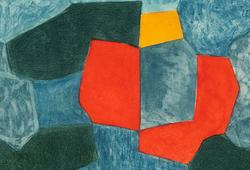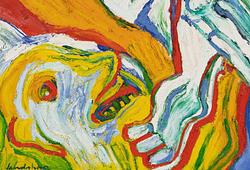Carl Larsson
"Åsnekärra i Barbizon"
Signed C.L and dated Barbizon 77. Oil on panel 22 x 37 cm.
Provenance
Private Collection, Sweden.
Exhibitions
Liljevalchs konsthall, Stockholm, "Carl Larsson, minnesutställning" 1953, cat. no. 51 (then owned by Professor G. Borelius).
More information
Barbizon, about an hour's journey from Paris, had attracted plein air painters with its picturesque surroundings and proximity to the Fontainebleau forest since 1848, when Jean-Francois Millet and Theodore Rousseau decided to follow in John Constable's nature-realistic footsteps. As early as 1824, the Paris Salon had exhibited Constable's paintings, which were executed with direct inspiration from nature. His painting sparked a wave of enthusiasm, a complete contrast to the strict rules of academic painting and studio work.
In 1877-78, Carl Larsson visited France for the first time. Relatively soon, he was drawn by Carl Skånberg to Barbizon, where artists flocked during the warm summer months.
In August 1877, Larsson wrote in a letter to his parents: "This letter I write in the countryside in the village of Barbizon, which lies at the edge of the famous large Fontainebleau forest. It resembles much of our forests in places where pines and birches grow among vast rock formations; but their oaks are hard to believe they are oaks, so different are they from ours – spindly and tall."
Larsson, however, allowed himself to be inspired by the landscape. A number of paintings from this time clearly show how the artist began to adopt the principles of French plein air painting. The compositions in question are characterised by colour harmony, sensitively tuned in soft and gentle tones.
However, the travel funds dwindled, and the journey home to Sweden was inevitable. In the autumn of 1880, Larsson returned to Paris, this time in the company of Ernst Josephson, according to a notice in Dagens Nyheter "to pursue art studies there."
Artist
Carl Larsson is considered one of the greatest Swedish artists of all time. He was born in Gamla Stan in Stockholm and studied at the Royal Academy of Arts in the years 1866-76. After his studies in Stockholm, he traveled to France and settled in Grèz-sur-Loing. There he mainly painted garden motifs. In France, he met his future wife Karin Bergöö, who was also an artist and came to mean a lot for his artistry. Already during his student years, he made a living as a photo retoucher and cartoonist in the press. It was also during his studies that Larsson got to know Anders Zorn and Bruno Liljefors, together the three are usually called the ABC artists. At the end of the 1880s, Carl and Karin were given "Lilla Hyttnäs" in Sundborn outside Falun by Karin's father, and this is where Larsson's most famous watercolors depicting his family were created. The motifs often depict sunny landscapes with children, crayfish fishing, meals in the green and interior scenes. Larsson is represented, among other, in the National Museum, where "Gustav Vasas intåg i Stockholm" and "Midvinterblot" fills the stairwell. Represented mainly at the National Museum in Stockholm and at the Gothenburg Art Museum.
Read more


















































